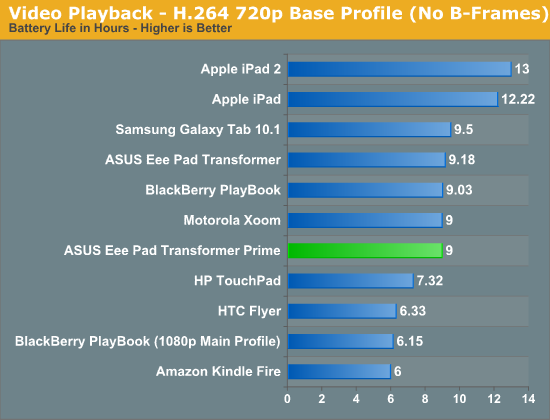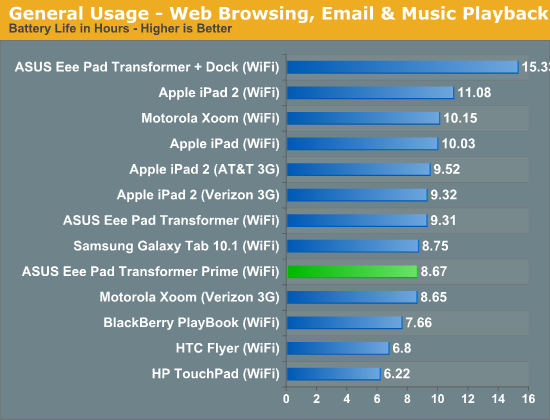ASUS Eee Pad Transformer Prime & NVIDIA Tegra 3 Review
by Anand Lal Shimpi on December 1, 2011 1:00 AM ESTBattery Life
With 39 hours to test I was pretty limited in what I could do when it came to battery life testing. I was able to run through two tests (one run a piece) and only in one configuration each. I wanted to see how Tegra 3 and the Prime fared in the worst case scenario so I picked the Normal power profile. Over the coming days I'll look at battery life in the other two profiles as well, not to mention run through more iterations of our test suite.
My bigger concern has to do with the malfunctioning WiFi in my review unit. For our video playback battery life test WiFi was on but not actively being used, those numbers should be ok. It's our general use test that loads web pages and downloads emails over WiFi and it's there that I believe things could've suffered a bit.
In both cases I saw around 9 hours of continuous battery life out of the Transformer Prime, without its dock. These numbers are a bit lower than the original Transformer but it's unclear to me how much of this is due to the additional cores/frequency or the misbehaving WiFi. The fact that we're within striking range of the original Transformer with the Prime running in Normal mode tells me that it's possible to actually exceed the Transformer's battery life with the Balanced or Power Saver profiles. That's very impressive for an SoC built on the same manufacturing process as its predecessor but with twice the CPU cores and a beefier GPU.


What I'm not seeing however is the impressive gains in battery life NVIDIA promised its companion core would deliver. I'm not saying that the companion core doesn't deliver a tangible improvement in battery life, I'm just saying that I need more time to know for sure.
That the Transformer Prime can deliver roughly the same battery life as its predecessor without any power profile tweaking may be good enough for many users. Both ASUS and NVIDIA shared their own numbers which peg the Prime's battery life in the 10 - 13 hour range. As I mentioned before, I'll have more data in the coming days.
Update - With a replacement Transformer Prime in house, battery life is looking a lot better already:

Update 2: Even more battery life results in our follow-up.










204 Comments
View All Comments
medi01 - Thursday, December 1, 2011 - link
So am I.But as I recently discovered, it's much easier to switch on tethering on my phone and connect via wi-fi than to swap sim card between devices..
It was hard for me to justify having 2 internet enabled sim cards, but it might be just me.
Kegetys - Thursday, December 1, 2011 - link
I find tethering to be a huge battery drain for the cellphone and it's usually not that practical either for anything else than occasional "emergency" use. But I have three sim cards from my carrier all with unlimited use anyway so I dont need to do any sim swapping. I guess if you need to pay extra for that then tethering is a reasonable alternative.MiSoFine - Thursday, December 1, 2011 - link
3 SIM cards with unlimited use for no extra cost? Who's your carrier? I was going to suck it up and pay AT&T the extra money for tethering, but if that's an option, I'll take it!Kegetys - Thursday, December 1, 2011 - link
> Who's your carrier?Saunalahti :)
medi01 - Thursday, December 1, 2011 - link
Hi,could you include "time it takes to fully charge" please?
On samsung tab it takes surprisingly long (about 4 hours) for some it might matter.
metafor - Thursday, December 1, 2011 - link
That's going to be true of any device that standardizes on a USB 2.0 connection -- which I think all Android tablets thus far use; it's just a different connector.iDevices sort of get around this by using a non-standard USB connection (up to 1A vs the standard 500mA) which is why it can charge faster.
It won't be until USB 3.0 becomes more common that charging speeds will really pick up.
Mugur - Friday, December 2, 2011 - link
Well, this is not quite right. My 2 phones have 1000mA chargers through USB even if the standard for pc is max 500mA. My Nook Color has a non standard but downwards compatible USB charger with around 1900mA.I agree though that the tablets recharge time is slow...
anandtech pirate - Thursday, December 1, 2011 - link
the PowerVR SGX 543MP2 is a beast. I still remember waaaay back when powerVR used to make pc graphic cards.Death666Angel - Thursday, December 1, 2011 - link
They still do Intel integrated graphics in the Atom, if I'm not mistaken. :-) They were the supplier of all Intel motherboard IGPs as well, though those aren't around anymore. :DPenti - Friday, December 2, 2011 - link
They were not the supplier of Intel's IGP's, only the Atom US15W/L/US11L one and some (not all) of the Atom integrated graphics in the CPU and in variants of SoC. Intel has made their own graphics since i740. Thus Intel GMA is their own tech. Own drivers. And so on. Only GMA500 and GMA600 (SoC), and newer GMA3600 and 3650, and likely GMA5650 in D2600/2700 is PowerVR. They don't have exactly excellent drivers for Windows and GNU/Linux desktops.GMA3150 is Intel, which runs in the latest Intel Atom N4XX and N5XX series, D4XX and D5XX.